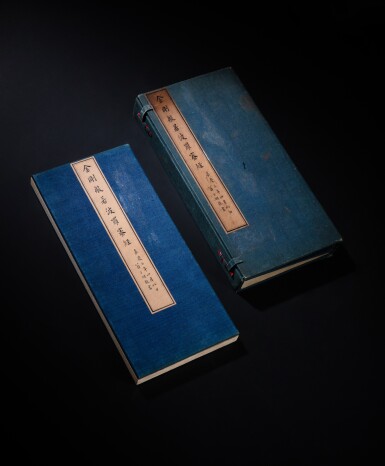Arts d'Asie
Arts d'Asie

PROPERTY FROM THE COLLECTION OF CHEN DING (1894-1971) | 陳定先生舊藏 (1894-1971)
Weng Fanggang 翁方綱 (1733-1818)
Weng Fanggang 翁方綱 | Vajra Prajnaparamita Sutra《金剛般若波羅密經》
Auction Closed
June 14, 03:20 PM GMT
Estimate
40,000 - 60,000 EUR
Lot Details
Description
Property from the Collection of Chen Ding (1894 - 1971)
Weng Fanggang (1733 - 1818)
Vajra Prajnaparamita Sutra
ink on paper, album of twenty leaves
signed Weng Fanggang, dated Jiaqing 3rd year (1798) and with two seals of the artist,
followed by Prajnamaramitra Sutra, signed Chen Maigang with seals, and dated in August 1958 with several scholar’s annotations by Zhong Gangzhong, Chen Yungao, Li Zhao Nian and others.
32.3 x 16 x 4 cm, 12¾ by 6¼ by 1⅝ in.
__________________________________________________________________________
Collection Chen Ding (1894-1971)
Weng Fanggang (1733 - 1818)
Sutras de Vajra Prajnaparamita
encre sur papier, album de douze feuilles
signé Weng Fanggang, daté de la 3e année de Jiaqing (1798) et avec deux sceaux de l'artiste
__________________________________________________________________________
陳定先生舊藏 (1894-1971)
翁方綱 (1733 - 1818)
《金剛般若波羅密經》
水墨紙本 十二開冊
封面題簽:金剛般若波羅密經。嘉慶三年四月八日(1798年),翁方綱敬書。
款識:大清嘉慶三年歲在戊午夏四月初八日,內閣侍讀學士翁方綱依壽春永慶寺石本盥手敬書。
鈐印:「臣方綱」、「敬書」
題跋(節選):
(陳枚功)般若波羅必多心經(經文略)。公曆一九五八年戊戌歲八月朔吉佛弟子陳枚功暢清晚號且佳老人道號顥成敬謹補寫隨順此經。鈐印:枚功八時後寫經之記、一鈐漫漶不辨
(鍾剛中)(文略不錄)。暢清同年屬題即心。鈐印:鍾剛中、桴
(陳雲誥)陳雲誥敬觀。鈐印:紫綸
(李兆年)李兆年敬觀。鈐印:漫漶不辨
Collection of Chen Meigong (1878 - 1975).
Collection of Chen Ding (1894 - 1971), and thence by descent.
__________________________________________________________________________
陳枚功收藏(1878-1975)
陳定收藏 (1894-1971),此後家族傳承
Scholar, historian and calligrapher, Weng Fanggang (1733-1818), also known by his artist names Tan Xi and Su Zhai, was a leading figure in the art world of the eighteenth century. Born in Wanping, just west of Beijing, to a scholarly family, Weng worked his way up through the imperial examination system, was appointed as a member of the Qianlong Emperor’s Grand Secretariat (neige) and was among those responsible for the compilation of the enormous imperial encyclopaedia, the Siku quanshu.
In terms of his calligraphy, Weng Fanggang is particularly well known for his work in cursive (zhangcao) and official script (kaishu). However, of all the extensive pieces of work Weng produced, there is one project that stands out; one that occupied over twenty-two years of his life: the copying of the Diamond Sutra (Jingangjing). Composed some time before the early fifth century, the sutra (known in Sanskrit as the Vajra Prajnaparamita) discusses the emptiness of all things and the liberation of oneself from earthly attachments, and emerged as one of the central texts of the Chinese Mahayana tradition. As an act of self-cultivation and religious devotion, Weng dedicated himself to copying out the sutra, alongside other Buddhist texts. According to records written by Weng himself, he resolved to write four copies of the Diamond Sutra every year from 1792 until 1817, just one year before his death. These sutras, of which only a small proportion have survived, showcase the versatility and vivacity of Weng’s skilled brushwork. Compare a facsimile of a sutra of very similar style – the 1764 original now lost – reproduced in Weng Su Zhai shu Jingangjing zhen ji [The Original Diamond Sutra of Weng Su Zhai], Shanghai, 1936. For a more comprehensive list of known Weng Fanggang Diamond Sutras, see Qiao Yuhong, “Weng Fanggang shoushu ‘Jingangjing’ cunshi kaozheng [Textual Research on the Existence of Weng Fanggang’s Handwritten Diamond Sutra]”, Meiri toutiao, 20th October 2017.
The fine group of classical Chinese painting and calligraphy in this section (lots 140-145) was assembled by diplomat and statesman Chen Ding in the first half of the 20th century. Born in Hunan in 1894, Chen was among the last generation to receive a classical Chinese education and developed a profound love for fine art that he sustained throughout his life. Joining the Ministry of Foreign Affairs in 1919, Chen went on to serve as Attaché to the Chinese Delegation to the League of Nations in 1925 and as its Secretary in Annual Assemblies of the League until 1927. Continuing to serve as a technical expert and delegate to various international committees until 1940, Chen’s dedication to his diplomatic career was rivalled only by his love of art. From a Diamond Sutra and correspondence by Qing calligrapher Weng Fanggang (lots 140 and 143), to more modern compositions, Chen’s collection is testament to his steadfast dedication to the Chinese artistic tradition.
Chen Ding’s love of art was a family trait. His ancestor Chen Jichang (1791-1849), represented here in lot 142, was a scholar-official and prolific calligrapher. Chen Jichang’s calligraphy later entered the collection of famed collector Zhang Xiaobing (1882-1968) who gave it back to the Chen family as a gift. This family heirloom, together with the sutra by Weng Fanggang and a piece of calligraphy by Lin Zexu, were passed down to Chen Ding by his elder brother Chen Meigong (1878-1975) circa 1960. Indeed, many of the lots presented here were sent to Chen Ding from family living back in China. Even when he had left China for a new life in Europe, Chen Ding's passion for Chinese art was never extinguished. These pieces, treasured over the years, were a taste of home.
學者、史家、書法家翁方綱(1733-1818),字檀溪,號蘇齋,為十八世紀藝苑翹楚。生於京西宛平書香之家,自幼秉承家學,潛心研習。歷科舉之程,步步晉升,擢任乾隆皇帝內閣中書,參與編纂《四庫全書》,貢獻良多。
翁氏書法以章草、楷書著稱於世,尤以抄寫《金剛經》之功最為顯著。此經乃五世紀初成書,梵名《金剛般若波羅蜜經》,論萬物皆空,脫離俗累,為大乘佛教之要典。翁氏以修身養性、虔誠事佛為志,自1792年起,每年抄寫《金剛經》四部,直至1817年,臨終前一年止,歷時二十二年。其所抄寫經文,存世僅少數,然皆顯其筆法之多變與生動。
可觀其風格相近之影印本,乃1764年所書原件,今已佚失,見刊於《翁蘇齋書金剛經真跡集》,上海,1936年。欲詳考翁方綱《金剛經》手稿存世,參閱喬宇宏《翁方綱手書〈金剛經〉存世考證》,載於《每日頭條》,2017年10月20日。
此組中國古典書畫珍品來自20世紀初外交政治家陳定先生之收藏。陳定,1894年生於湖南名門,自幼受中國傳統教育薰陶,一生鍾情於中國藝術。1919年,陳定任職於外交部,1925年擔任中國駐國際聯盟代表團隨員,1927年前任國際聯盟年會秘書,隨後擔任技術專家及多個國際委員會代表,直至1940年。陳定對外交事業之奉獻與對藝術之熱愛並重,此收藏中包括清代書法家翁方綱之《金剛經》和手札墨跡(拍品編號140及143),以及其他近代名人之作,見證陳定對中國傳統藝術之深厚情感。
陳定對藝術之熱愛,乃家族遺風。其祖陳繼昌(1791-1849),即拍品編號142號作者,為中國最後一位「三元及第」。此作後入名收藏家張效彬(1882-1968)之藏,張氏後以此返贈陳家為禮。此家族傳之為寶,與翁方綱之金剛經及林則徐之一幅書法,約於1960年由陳定伯兄陳枚功(1878-1975)傳於陳定。誠然,本收藏皆由在中國之家人寄予陳定。即便陳定已離中國,移居歐洲展開新生活,其對中國藝術之熱忱從未稍減。此等珍藏多年的藝術品,乃其心中一抹鄉愁。
